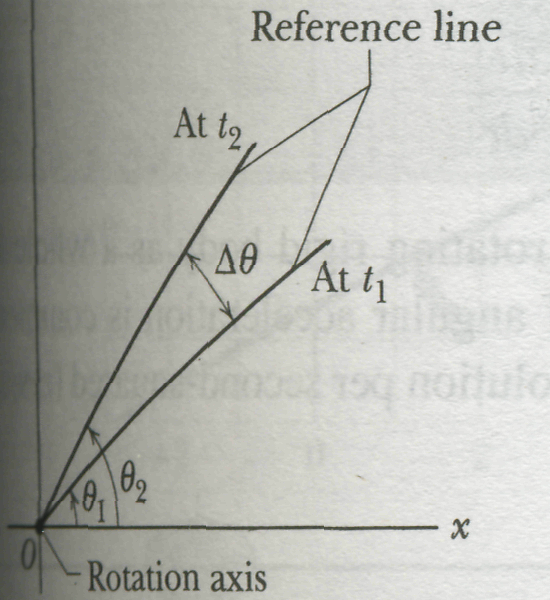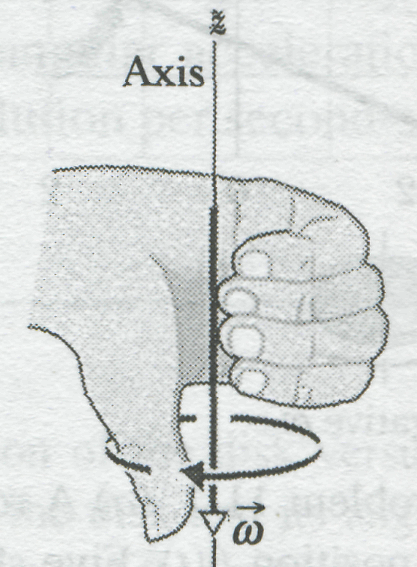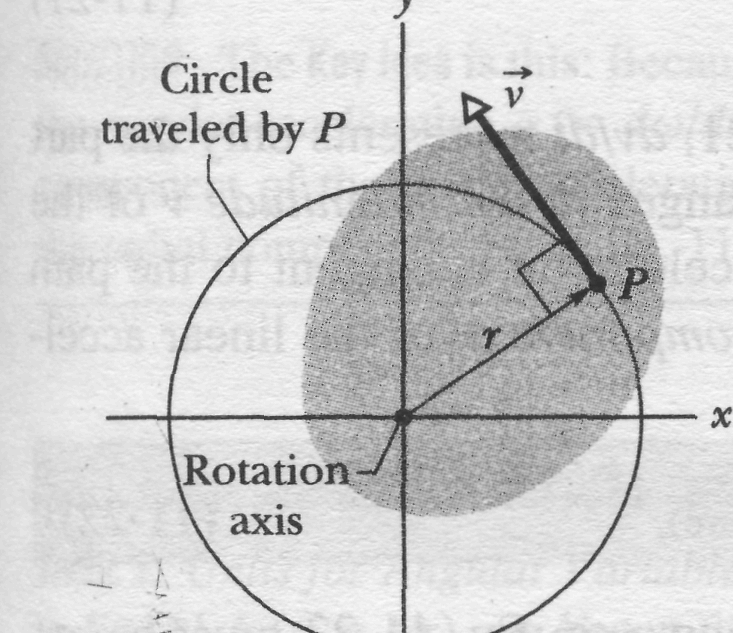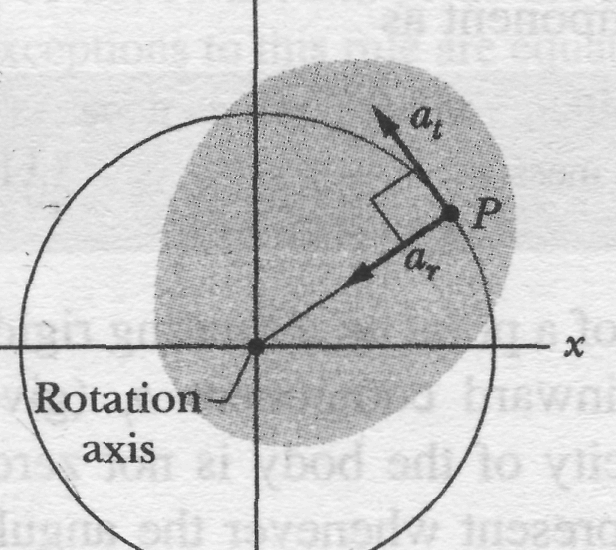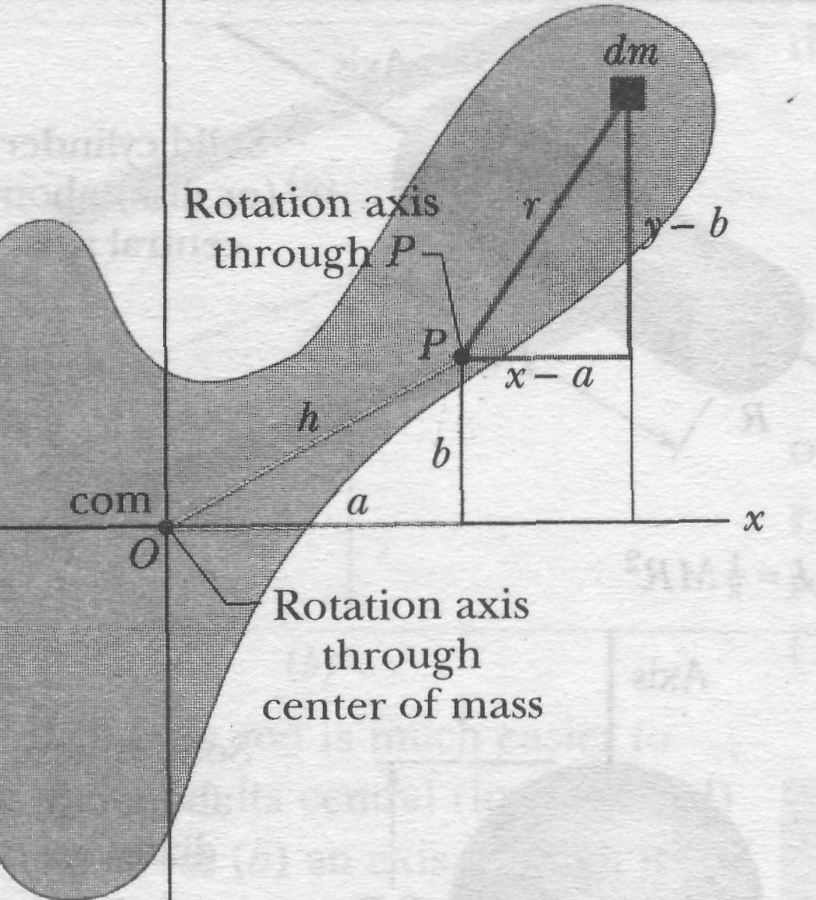
- •Mechanics Kinematics
- •1.2 Position and Displacement
- •Velocity and Coordinate by Integration
- •Dynamics of Translational Motion
- •The Concept of Forces
- •1.15. Rocket Propulsion (Example of Variable Mass Situation)
- •2 Path Independence of Conservative forces
- •Gravitational Potential Energy
- •Isolated System
- •Rotational motion
- •Angular Position
- •Angular Displacement
- •Angular Velocity
- •5.3.1. Uniform slender rod; axis perpendicular to length rod
- •5.3.2. Hollow or solid cylinder
- •5.3.3. Uniform sphere of radius , axis through center
Angular Displacement
If the body
of Fig. 11-3 rotates about the rotation axis as in Fig. 11-4,
changing the angular
position of the reference line from
![]() to
to
![]() ,
the
body undergoes an angular
displacement
,
the
body undergoes an angular
displacement
![]() given by
given by
![]()
This definition of angular displacement holds not only for the rigid body as a whole but also for every particle within that body because the particles are all locked together.
If a body is in translational motion along an axis, its displacement is either positive or negative, depending on whether the body is moving in the positive or negative direction of the axis. Similarly, the angular displacement of a rotating body is either positive or negative, according to the following rule:
An angular displacement in the counterclockwise direction is positive, and one in the clockwise direction is negative.
Angular Velocity
Suppose
(see Fig. 11-4) that our rotating body is at angular position
at
time
and
at angular position
at time
![]() .
We
define the average
angular
velocity
of
the body
in the time interval
from
to
to
be
.
We
define the average
angular
velocity
of
the body
in the time interval
from
to
to
be
![]() 11
-5
11
-5
in which
is
the angular displacement that occurs during
(![]() is
the lowercase Greek letter omega).
is
the lowercase Greek letter omega).
The (instantaneous) angular velocity , with which we shall be most concemed, is the limit of the ratio in Eq. 11 -5 as approaches zero. Thus,
![]() 11 -6
11 -6


 If
we know
,
we
can find the angular velocity
by
differentiation.
If
we know
,
we
can find the angular velocity
by
differentiation.
Fig. 11-4 |
Equations 11-5 and 11-6 hold not only for the rotating rigid body as a whole but also for every particle of that body because the particles are all locked together. The unit of angular velocity is commonly the radian per second (rad/s) or the revolution per second (rev/s).
If a particle moves in translation along an axis, its linear velocity is either positive or negative, depending on whether the particle is moving in the positive or negative direction of the axis. Similarly, the angular velocity of a rotating rigid body is either positive or negative, depending on whether the body is rotating counterclockwise (positive) or clockwise (negative). The magnitude of an angular velocity is called the angular speed, which is also represented with .
Angular Acceleration
If the
angular velocity of a rotating body is not constant, then the body
has an angular acceleration. Let
![]() and
and
![]() be
its angular velocities at times
be
its angular velocities at times
![]() and
and
![]() ,
respectively,
The average
angular acceleration
of
the rotating body in the interval from
to
is
defined as
,
respectively,
The average
angular acceleration
of
the rotating body in the interval from
to
is
defined as
![]() 11
-7
11
-7
in which
![]() is
the change in the angular velocity that occurs during the time
interval
.
The
(instantaneous)
angular acceleration
is
the change in the angular velocity that occurs during the time
interval
.
The
(instantaneous)
angular acceleration
![]() ,
with
which we shall be most concerned, is the limit of this quantity as
approaches zero. Thus,
,
with
which we shall be most concerned, is the limit of this quantity as
approaches zero. Thus,
![]() 11-8
11-8
Equations 11-7 and 11-8 hold not only for the rotating rigid body as a whole but also for every particle of that body. The unit of angular acceleration is commonly the radian per second-squared (rad/s2) or the revolution per second-squared (rev/s2).
11-3 Are Angular Quantities Vectors?
We can describe the position, velocity, and acceleration of a single particle by means of vectors. If the particle is confined to a straight line, however, we do not really need vector notation. Such a particle has only two directions available to it, and we can indicate these directions with plus and minus signs.
In the same way, a rigid body rotating about a fixed axis can rotate only clockwise or counterclockwise as seen along the axis, and again we can select between the two directions by means of plus and minus signs. The question arises: "Can we treat the angular displacement, velocity, and acceleration of a rotating body as vectors?" The answer is a qualified "yes"
In the same way, a rigid body rotating about a fixed axis can rotate only clock-
Figure 1-l6a |
|
Fig. 11-6c |
|
wise or counterclockwise as seen along the axis, and again we can select between the two directions by means of plus and minus signs. The question arises: "Can we treat the angular displacement, velocity, and acceleration of a rotating body as vectors?" The answer is a qualified "yes"
Consider
the angular velocity. Figure 1 l-6a
shows
a vinyl record rotating on a turntable.
The record has a constant angular speed
=
33![]() rev/min) in the clock-wise
direction. We can represent its angular velocity as a vector
rev/min) in the clock-wise
direction. We can represent its angular velocity as a vector
![]() pointing
along the
axis of rotation,.
Here's
how: We choose the length of this vector according
to some convenient scale, for example, with 1 cm corresponding to 10
rev/min.
Then we establish a direction for the vector
by
using a right-hand rule, as
Fig. 11-6c shows: Curl your right hand about the rotating record,
your fingers I pointing
in
the direction of rotation. Your
extended thumb will then point in the direction
of the angular velocity vector. If the record were to rotate in the
opposite sense,
the right-hand rule would tell you that the angular velocity vector
then points in
the opposite direction.
pointing
along the
axis of rotation,.
Here's
how: We choose the length of this vector according
to some convenient scale, for example, with 1 cm corresponding to 10
rev/min.
Then we establish a direction for the vector
by
using a right-hand rule, as
Fig. 11-6c shows: Curl your right hand about the rotating record,
your fingers I pointing
in
the direction of rotation. Your
extended thumb will then point in the direction
of the angular velocity vector. If the record were to rotate in the
opposite sense,
the right-hand rule would tell you that the angular velocity vector
then points in
the opposite direction.
It is not easy to get used to representing angular quantities as vectors. We instinctively expect that something should be moving along the direction of a vector. That is not the case here. Instead, something (the rigid body) is rotating around the direction of the vector. In the world of pure rotation, a vector defines an axis of rotation, not a direction in which something moves. Nonetheless, the vector also defines the motion. The angular acceleration is another vector, and it too obeys those rules.
11-5 Relating the Linear and Angular Variables
In Section 4-7, we discussed uniform circular motion, in which a particle travels at constant linear speed along a circle and around an axis of rotation. When a rigid body, such as a merry-go-round, rotates around an axis, each particle in the body moves in its own circle around that axis. Since the body is rigid, all the particles make one revolution in the same amount of time; that is, they all have the same angular speed .
However, the farther a particle is from the axis, the greater the circumference of its circle is, and so the faster its linear speed must be. You can notice this on a merry-go-round. You turn with the same angular speed regardless of your distance from the center, but your linear speed increases noticeably if you move to the outside edge of the merry-go-round.
We often need to relate the linear variables , , and for a particular point in a rotating body to the angular variables , , and for that body. The two sets of variables are related by , the perpendicular distance of the point from the rotation axis. This perpendicular distance is the distance between the point and the rotation axis, measured along a perpendicular to the axis. It is also the radius of the circle traveled by the point around the axis of rotation.
The Position
If a reference line on a rigid body rotates through an angle 0, a point within the body at a position from the rotation axis moves a distance along a circular arc, where is given by Eq. 11-1:
![]() (radian
measure). 11-17
(radian
measure). 11-17

 This
is the first of our linear-angular relations. Caution:
The
angle
here
must be measured in radians because Eq. 11-17 is itself the
definition of angular measure in radians.
This
is the first of our linear-angular relations. Caution:
The
angle
here
must be measured in radians because Eq. 11-17 is itself the
definition of angular measure in radians.
|
|
|
|
The Speed
Differentiating Eq. 11-17 with respect to time - with held constant - leads to
![]()
However,
![]() is
the linear speed (the magnitude of the linear velocity) of the point
in question, and
is
the linear speed (the magnitude of the linear velocity) of the point
in question, and
![]() is
the angular speed
of
the rotating body. So
is
the angular speed
of
the rotating body. So
![]() (radian
measure).
11-18
(radian
measure).
11-18
Caution: The angular speed must be expressed in radian measure.
Equation 11-18 tells us that since all points within the rigid body have the same angular speed , points with greater radius have greater linear speed . Figure 1 l-9a reminds us that the linear velocity is always tangent to the circular path of the point in question.
The Acceleration
Differentiating Eq. 11-18 with respect to time - again with held constant-leads to
![]()
Here we run
up against a complication. In Eq. 11-21,
![]() represents
only the part of the linear acceleration that is responsible for
changes in the magnitude
of
the linear velocity
.
Like
,
that part of the linear acceleration is tangent to the path of the
point in question. We call it the tangential
component
represents
only the part of the linear acceleration that is responsible for
changes in the magnitude
of
the linear velocity
.
Like
,
that part of the linear acceleration is tangent to the path of the
point in question. We call it the tangential
component
![]() of
the linear acceleration of the point, and we write
of
the linear acceleration of the point, and we write
![]() 11-22
(radian measure),
11-22
(radian measure),
where
![]() .
Caution: The
angular acceleration
in
Eq. 11-22 must be expressed in radian measure.
.
Caution: The
angular acceleration
in
Eq. 11-22 must be expressed in radian measure.
In
addition, as Eq. 4-32 tells us, a particle (or point) moving in a
circular path has a radial
component of
linear acceleration,
![]() (directed radially inward), that is responsible for changes in the
direction
of
the linear velocity
.
By substituting for
from Eq. 11-18, we can write this component as
(directed radially inward), that is responsible for changes in the
direction
of
the linear velocity
.
By substituting for
from Eq. 11-18, we can write this component as
![]() (radian
measure).
(radian
measure).
Thus, as
Fig. 1 l-9b
shows,
the linear acceleration of a point on a rotating rigid body has, in
general, two components. The radially inward component
![]() (given
by Eq. 11-23) is present whenever the angular velocity of the body is
not zero. The tangential component
(given
by Eq. 11-22) is present whenever the angular acceleration is not
zero.
(given
by Eq. 11-23) is present whenever the angular velocity of the body is
not zero. The tangential component
(given
by Eq. 11-22) is present whenever the angular acceleration is not
zero.
11-6 Kinetic Energy of Rotation
The rapidly
rotating blade of a table saw certainly has kinetic energy due to
that rotation. How can we express the energy? We cannot apply the
familiar formula
![]() to
the saw as a whole because that would only give us the kinetic energy
of the saw's center of mass, which is zero.
to
the saw as a whole because that would only give us the kinetic energy
of the saw's center of mass, which is zero.
Instead, we shall treat the table saw (and any other rotating rigid body) as a collection of particles with different speeds. We can then add up the kinetic energies of all the particles to find the kinetic energy of the body as a whole. In this way we obtain, for the kinetic energy of a rotating body,
![]()
in which
![]() is
the mass of the
-th
particle and
is its speed. The sum is taken over all the particles in the body.
is
the mass of the
-th
particle and
is its speed. The sum is taken over all the particles in the body.
The problem with Eq. 11-24 is that is not the same for all particles. We solve this problem by substituting for from Eq. 11-18 ( ), so that we have
![]()
in which is the same for all particles.
The
quantity in parentheses on the right side of Eq. 11-25 tells us how
the mass of the rotating body is distributed about its axis of
rotation. We call that quantity the rotational
inertia
(or
moment
of inertia)
![]() of
the body with respect to the axis of rotation. It is a constant for a
particular rigid body and a particular rotation axis. (That axis must
always be specified if the value of
is to be meaningful.)
of
the body with respect to the axis of rotation. It is a constant for a
particular rigid body and a particular rotation axis. (That axis must
always be specified if the value of
is to be meaningful.)
We may now write
![]() 11-26
11-26
and substitute into Eq. 11-25
![]() 11-27
11-27
as the expression we seek. Because we have used the relation in deriving Eq. 11-27, must be expressed in radian measure. The SI unit for is the kilogram-square meter (kg • m2).
Equation
11-27, which gives the kinetic energy of a rigid body in pure
rotation, is the angular equivalent of the formula
![]() ,
which
gives the kinetic energy of a rigid body in pure translation. In both
formulas there is a factor of 1/2.
Where
mass M
appears
in one equation,
(which involves both mass and its distribution) appears in the other.
Finally, each equation contains as a factor the square of a speed -
translational or rotational as appropriate. The kinetic energies of
translation and of rotation are not different kinds of energy. They
are both kinetic energy, expressed in ways that are appropriate to
the motion at hand.
,
which
gives the kinetic energy of a rigid body in pure translation. In both
formulas there is a factor of 1/2.
Where
mass M
appears
in one equation,
(which involves both mass and its distribution) appears in the other.
Finally, each equation contains as a factor the square of a speed -
translational or rotational as appropriate. The kinetic energies of
translation and of rotation are not different kinds of energy. They
are both kinetic energy, expressed in ways that are appropriate to
the motion at hand.
We noted previously that the rotational inertia of a rotating body involves not only its mass but also how that mass is distributed. Here is an example that you can literally feel. Rotate a long, fairly heavy rod (a pole, a length of lumber, or something similar), first around its central (longitudinal) axis (Fig. 11-1 la) and then around an axis perpendicular to the rod and through the center (Fig. 11-116). Both rotations involve the very same mass, but the first rotation is much easier than the second. The reason is that the mass is distributed much closer to the rotation axis in the first rotation. As a result, the rotational inertia of the rod is much smaller in Fig. 11-Ш than in Fig. 11-1 lb. In general, smaller rotational inertia means easier rotation.
Parallel-Axis Theorem
Suppose we
want to find the rotational inertia / of a body of mass
about
a given axis. In principle, we can always find / with the integration
of Eq. 11-28. However, there is a shortcut if we happen to already
know the rotational inertia
![]() of the body about a parallel
axis
that extends through the body's center of mass. Let
be
the perpendicular distance between the given axis and the axis
through the center of mass (remember these two axes must be
parallel). Then the rotational inertia
about the given axis is
of the body about a parallel
axis
that extends through the body's center of mass. Let
be
the perpendicular distance between the given axis and the axis
through the center of mass (remember these two axes must be
parallel). Then the rotational inertia
about the given axis is
![]() (parallel-axis
theorem). (11-29)
(parallel-axis
theorem). (11-29)
This equation is known as the parallel-axis theorem. We shall now prove it.
Proof of the Parallel-Axis Theorem
Fig. 11-12 |
Let О be the center of mass of the arbitrarily shaped body shown in cross section in Fig. 11-12. Place the origin of the coordinates at O. Consider an axis through O perpendicular to the plane of the figure, and another axis through point P parallel to the first axis. Let the x and у coordinates of P be a and b.
Let be a mass element with the general coordinates x and y. The rotational inertia of the body about the axis through P is then, from Eq. 11-28,
![]()
which we can rearrange as
![]() 11-30
11-30
From the
definition of the center of mass (Eq. 9-9), the middle two integrals
of Eq. 11-30 give the coordinates of the center of mass (multiplied
by a constant) and thus must each be zero. Because
![]() is
equal to
is
equal to
![]() ,
where
is
the distance from О
to
,
the
first integral is simply
,
the rotational inertia of the body about an axis through its center
of mass. Inspection of Fig. 11-12 shows that the last term in Eq.
11-30 is
,
where
is
the distance from О
to
,
the
first integral is simply
,
the rotational inertia of the body about an axis through its center
of mass. Inspection of Fig. 11-12 shows that the last term in Eq.
11-30 is
![]() ,
where
is
the body's total mass. Thus, Eq. 11-30 reduces to Eq. 11-29, which is
the relation that we set out to prove.
,
where
is
the body's total mass. Thus, Eq. 11-30 reduces to Eq. 11-29, which is
the relation that we set out to prove.
ТО FIND MOMENT OF INERTIA OF A RIGID BODY
The moment of inertia of a symmetrical body rotating about its axis of symmetry can be found by finding the moment of inertia of a small element of it about the axis of rotation and then integrating it within the proper limits for whole of the body.
Consider that a small elementary portion of mass of the rigid body rotates about the axis of rotation at a distance from it. Then, moment of inertia of the small elementary portion about the axis of rotation,
![]()
The moment of inertia of the whole rigid body about the axis of rotation,
![]() ...(3.09)
...(3.09)
If the
rigid body is made of material of uniform density
![]() and
and
![]() is
the volume of the elementary portion of the body, then
is
the volume of the elementary portion of the body, then
![]() .
Hence,
moment of inertia of the rigid body about the axis of rotation,
.
Hence,
moment of inertia of the rigid body about the axis of rotation,
![]() ...(3.10)
...(3.10)
In using this equation, we express the volume element dV in terms of the differentials of the integration variables, usually the coordinates of the volume elements. The element dV must always be chosen so that all points within it are at very nearly the same distance from the axis of rotation. For regularly shaped bodies this integration can be after be carried out quite easily. Discuss several examples.
In case the rigid body is a plane lamina,
![]()
where dA
is
area of the elementary portion of the plane lamine and
![]() its
mass per unit area.
its
mass per unit area.

